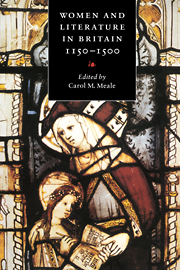Book contents
- Frontmatter
- Contents
- List of illustrations
- List of abbreviations
- Chronology: women and literature in Britain, 1150–1500
- Introduction
- 1 The power and the weakness of women in Anglo-Norman romance
- 2 Women as lovers in early English romance
- 3 Mothers in Middle English romance
- 4 ‘Clerc u lai, muïne u dame’: women and Anglo-Norman hagiography in the twelfth and thirteenth centuries
- 5 Women in No Man's Land: English recluses and the development of vernacular literature in the twelfth and thirteenth centuries
- 6 ‘Women talking about the things of God’: a late medieval sub-culture
- 7 ‘… alle the bokes that I haue of latyn, englisch, and frensch’: laywomen and their books in late medieval England
- 8 Women authors and women's literacy in fourteenth- and fifteenth-century England
- 9 Women and their poetry in medieval Wales
- Further reading
- Index of manuscripts
- Index of names and titles
5 - Women in No Man's Land: English recluses and the development of vernacular literature in the twelfth and thirteenth centuries
Published online by Cambridge University Press: 09 November 2009
- Frontmatter
- Contents
- List of illustrations
- List of abbreviations
- Chronology: women and literature in Britain, 1150–1500
- Introduction
- 1 The power and the weakness of women in Anglo-Norman romance
- 2 Women as lovers in early English romance
- 3 Mothers in Middle English romance
- 4 ‘Clerc u lai, muïne u dame’: women and Anglo-Norman hagiography in the twelfth and thirteenth centuries
- 5 Women in No Man's Land: English recluses and the development of vernacular literature in the twelfth and thirteenth centuries
- 6 ‘Women talking about the things of God’: a late medieval sub-culture
- 7 ‘… alle the bokes that I haue of latyn, englisch, and frensch’: laywomen and their books in late medieval England
- 8 Women authors and women's literacy in fourteenth- and fifteenth-century England
- 9 Women and their poetry in medieval Wales
- Further reading
- Index of manuscripts
- Index of names and titles
Summary
How far is it possible to discuss the relationship of women and literature in a period which had no real equivalent to our modern concept of literature? There is not a great deal of semantic overlap between Modern English ‘literature’ and its Medieval Latin ancestor litteratura. Both can mean ‘what is written, a body of writing’ but ‘literature’ is primarily associated with entertainment, litteratura with learning. In the twelfth and thirteenth centuries, litteratura was used only of works written in Latin; and its commonest meaning was not ‘literature’ even in this specialised sense, but ‘knowledge of Latin letters, scholarship’.
The extent of the semantic change here suggests the extent of the cultural changes which underlie it. Latin was the standard written language of early medieval Europe, and (although pre-Conquest Britain was a notable exception) writing in the vernacular was rare before the twelfth century. To be litteratus was not simply to be literate, but to be able to read and write in Latin. In the earlier Middle Ages, litteratura in this sense was normally (though not invariably) confined to those who had entered the religious life, and litteratus and clericus eventually came to be used as near-synonyms, as did illitteratus and laicus. The material that the clerici considered worth preserving in writing was not necessarily representative of the culture of their society as a whole. Herbert Grundmann argues:
in the Middle Ages, the concepts litteratus and illitteratus distinguish not different educational levels, but different kinds of education, indeed cultural worlds, which exist simultaneously with and alongside each other; since alongside the Latin tradition of books and writing, going back to Roman antiquity and Biblical and patristic tradition, the vernacular languages, with their own unwritten traditions of poetry, history and saga, law and custom, survived and had their own cultural impact.
- Type
- Chapter
- Information
- Women and Literature in Britain, 1150–1500 , pp. 86 - 103Publisher: Cambridge University PressPrint publication year: 1993
- 7
- Cited by

